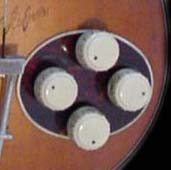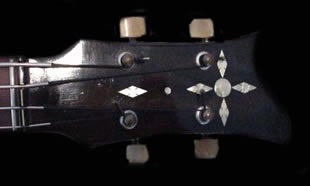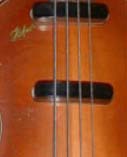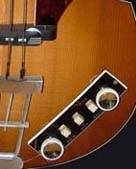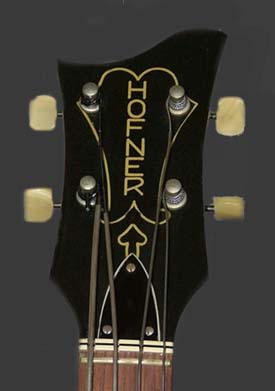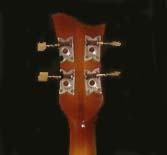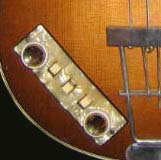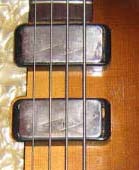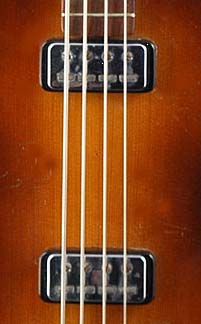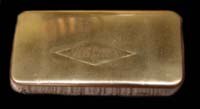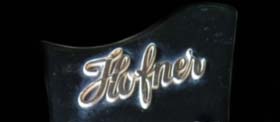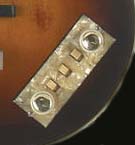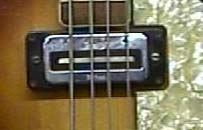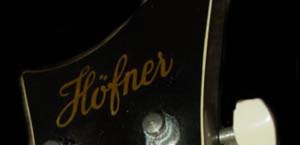
Hofner Basses &
Guitars in Chicago

![]()

Hofner 500/1 Bass • Hofner Beatle Bass • Dating Hofner Bases • Hofner Serial Numbers
Hofner Model 500/1 "Beatle Bass" History and Dating Tips |
|---|
In 1961 Paul McCartney purchased a left handed Hofner 500/1 Violin Bass from Steinway's Music in Hamburg Germany, an event that would make Hofner a recognized brand word wide. As the popularity of McCartney's band increased, the 500/1 Hofner violin bass earned it's nick name "the Beatle Bass" forever linked to the most popular band of the 20th century. The 500/1 bass featured a symmetrical violin style design, was very light weight, had very good playability and a was offered at a reasonable price. The 500/1 was conceived in 1955 by Walter Hofner who believed a violin shaped bass would be easy to manufacturer along side of his existing double bass production line. The 500/1 was unveiled in 1956 at the Frankfurt Music Fair. It's ironic but the 500/1 was not available in the UK until 1963. The Selmer company began importing Hofner guitars into Great Britain in 1958 however they did not import 500/1 violin basses until about 1963. It's a good thing McCartney visited Steinway's Music otherwise the Beatles might be known for using a Fender or Rickenbacker bass ! The 500/1 featured a hollow body, flat back (until 1962), light weight and short 30" scale. The back and sides were made of laminated flamed maple with a solid spruce top. Later the top was changed to laminated spruce. The fret board was made from Brazilian or Indian rosewood and had 20 frets (the 1957 models had 21 frets). The finish consisted of nitro-cellulose lacquer. Early Hofner basses used strip style tuners however later models used individual tuning machines. 500/1 necks were originally quite fat using solid maple but truss rods were added later to allow a smaller stronger neck. Pickups were originally positioned in traditional neck and bridge locations however in pickups were moved together in late 56 close to the neck however they were moved apart again in 1962 to improve tone. It should be noted that Hofner did not included serial numbers on early 500/1 basses however many distributors added their own serial numbers to the headstock or near the tailpiece. Dating Vintage Hofner basses is always tricky as transitions were often gradual and older parts can appear on newer models depending on parts supplies and other factors. Here are a few general rules of thumb that can be used as general guidelines but there are always exceptions to these guidelines. When in doubt pick up a book or two about dating Hofners and be sure to consult several sources.
General Hofner Bass Dating Guidelines
1955-56 Hofner 500/1 Violin Bass: The original 500/1 Violin Bass featured shown above featured oval control panel, diamonds on the headstock, flat body back, a small Hofner logo on the body and 20 frets.
1958 Hofner 500/1 Violin Bass: Truss rods were added to the neck allowing a smaller, thinner and stronger neck and of course a truss rod cover was added.
1961-1963 Hofner Beatle Bass: A new horizontal gold script logo decal was used on the headstock Closed pickups were added with the Hofner name inside a diamond. Late 61 saw pickups add adjustment screws. In 62 pickups moved further apart.
1968 Hofner 500/1 Violin Bass: The heel is now considerably rounded from previous years. Luxury models such as the 5000/1 were introduced.
Hofner still manufactures the 500/1 Bass as well as several variations. Current lines include the Hofner Club Series and Reissue 500 and 5001 Violin Basses as well as limited edition reissues such as the 1959 specification H500/1-59.
Serial Number Dating 1975 to 1984
1986 to Present (note letter I is not used)
Pot Code Dating: Pots are date coded with the first 2 digits representing the week and the next digit representing the year. The only problem is that the code repeats every 10 years. For example a code 259 would be 25the week of 1969, 79 or 89 so you will have to use a variety of data to date your Hofner Bass. Also keep in mind that transitions were not absolute so some basses may have used older parts left over from prior years.
|
|---|
 |
Contact Information: Email: Sales@beatlebassdealer.com Beatle Bass Dealer/Rock N Roll Vintage Store Address: 4727 N. Damen Ave Chicago, IL 60625 |
|
![]()
Copyright 2015 - All trademarks are property of their respective owners.
